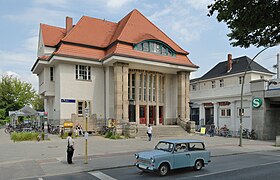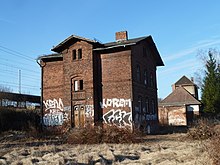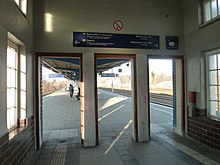Berlin-Blankenburg train station
| Berlin-Blankenburg | |
|---|---|
|
Entrance building of Ernst Schwartz and Karl Cornelius
|
|
| Data | |
| Location in the network | Separation station |
| Design | Through station |
| Platform tracks | 2 |
| abbreviation | BBKB (long-distance train) BBLB (S-Bahn) |
| IBNR | 8089056 |
| Price range | 4th |
| opening | June 1, 1877 |
| Website URL | sbahn.berlin |
| Profile on Bahnhof.de | Berlin-Blankenburg |
| Architectural data | |
| Architectural style | Neoclassicism |
| architect | Ernst Schwartz , Karl Cornelius |
| location | |
| City / municipality | Berlin |
| Place / district | Blankenburg |
| country | Berlin |
| Country | Germany |
| Coordinates | 52 ° 35 '28 " N , 13 ° 26' 35" E |
| Railway lines | |
|
|
| Railway stations in Berlin | |
The Berlin-Blankenburg train station is served by the Berlin S-Bahn . This is where the S-Bahn routes branch off along the Szczecin Railway and to the Berlin outer ring . In the 1960s and 1970s, it was also a transfer point to steam or diesel-powered suburban trains. The station with its neoclassical reception building is a listed building.
Location and name
The train station is located in the west of the Berlin district of Blankenburg, not far from the border with the Buchholz district in the Pankow district in the north of Berlin . The station is at the 8.43 kilometer of the Szczecin Railway in an elevated position. In the station area, the tracks cross Bahnhofstrasse on a bridge. About two kilometers north of the train station is the Karower Kreuz , where the Berlin outer ring crosses the Szczecin Railway. Originally the station was only called Blankenburg , later Blankenburg (b Berlin) .
history
The Stettiner Bahn, which opened in 1843, had no intermediate stations for passenger traffic between Berlin and Bernau for over 30 years. The first stop on the way was the Blankenburg station on June 1, 1877, followed a few weeks later by the Gesundbrunnen station , the ring rail section of which had already opened a few years earlier. With the opening of additional stations, suburban traffic between Berlin and Bernau via Blankenburg grew steadily in the years that followed.
A freight line from Friedrichsfelde to Blankenburg went into operation for freight traffic in 1907 , and was extended a year later via Lübars to Tegel . This industrial line Tegel – Friedrichsfelde crosses under the Stettiner Bahn south of Blankenburg station and was connected to Blankenburg station via a connecting track.
As a result of the strong growth in suburban traffic, the Szczecin Railway was expanded to four tracks between 1906 and 1911, long-distance and suburban traffic was separated and the tracks in the Blankenburg area were moved to a dam. The station's facilities were completely rebuilt, and the station building also comes from that time. The suburban line to Bernau and with it the Blankenburg train station was the first line to be electrified with direct current in 1924. In Blankenburg, a sweeping and parking facility was built for the direct current trains called the S-Bahn a little later .
To bypass West Berlin , the Berlin outer ring was built in the early 1950s . At the Karower Kreuz, connecting curves to the Stettiner Bahn were set up, which were operationally connected to Blankenburg station. Until the Berlin Wall was built in 1961, S-Bahn traffic ran unhindered between the two parts of Berlin. After the Wall was built, the S-Bahn trains from Blankenburg no longer ran in the direction of Berlin-Gesundbrunnen, but exclusively on the eastern ring line . At the end of 1961, an S-Bahn branch from Blankenburg station to the outer ring for trains in the direction of Oranienburg went into operation. The trains of the Heidekrautbahn from Basdorf could no longer run to Berlin-Wilhelmsruh station as a result of the construction of the Wall . A provisional platform was built for them in Blankenburg at the exit group to the industrial railway. It was on the other side of the tracks on the other side of Bahnhofstrasse and was difficult to get to from the S-Bahn platform, which met with criticism from passengers. Since 1976 the trains from Basdorf have ended at the S-Bahn platform in Karow ; the platform in Blankenburg was dismantled.
The station was of little importance in freight traffic; its most important function was as a connecting station to the industrial railway. The section of the industrial railway across the sector border had already been interrupted in 1952. The connections in the Buchholz and Niederschönhausen area to the west of Blankenberg train station were served until 1972. The line was then dismantled because of the construction of the motorway to Pankow , which runs directly west of the train station. In 1988 the industrial line between Marzahn and Weißensee was interrupted, so that only a few connections in the Weißensee area were served from Blankenburg. After the fall of the Wall, operations on the industrial railway were completely stopped and the facilities were dismantled.
After the closure of the nearby Pankow marshalling yard in 1997, the long-distance tracks in the Blankenburg area were interrupted for a few years. Between 2003 and 2005, the bridges of the S-Bahn tracks across Bahnhofstrasse were renewed, with some of the long-distance tracks being used as replacements. In 2006, the renewed long-distance tracks went into operation in connection with the construction of the north-south long-distance line through Berlin and the new Berlin Central Station .
Investments
The original station was south of Bahnhofstrasse, which crossed the railroad tracks at ground level. For a long time, a station keeper's house with a stable building to the east of the track system remained from this station. The two vacant buildings were placed under monument protection, but are no longer included in the 2014 list of monuments and were demolished in the same year.
Since the line was expanded at the beginning of the 20th century, the tracks have been elevated and the station building north of Bahnhofsstraße. The building, built according to plans by Karl Cornelius and Ernst Schwartz, corresponds in its basic features to the reception buildings on the Szczecin Railway in Pankow , Pankow-Heinersdorf , Karow , Buch , Röntgen and Zepernick, which were built around the same time by the same architects . Like almost all of these stations, the reception building is a plastered two-storey brick building on a limestone base with a hipped roof and an outside staircase with wrought-iron lights. Most of the building is next to the track structure. In particular, the counter hall and the rooms in which staff were constantly present, such as ticket issuance and staff rooms, were arranged in this part. The access hall is located under the tracks. The platform was provided with a single-stem wooden roof with riveted solid wall supports. The ensemble of “reception building with connecting corridor, staircase and platform” is a listed building.
The platform access is at the southwest end of the platform; To the north of the platforms are the sweeping system and the separation of the S-Bahn tracks in the direction of Karow and the direction of the outer ring. To the southeast of the S-Bahn tracks and the platform are the tracks of the long-distance railway; beyond the long-distance railway tracks of the signal box.
As one of 20 so-called main stations of the Berlin S-Bahn, the station is manned by local supervision.
Connection
The station was always primarily used for suburban traffic. In 1905 trains ran roughly every hour between Berlin and Bernau with a stop in Blankenburg, and there were also a few amplifier trains between Berlin and Blankenburg. After the suburban tracks were separated from long-distance traffic, the offer was further increased. After electrification, the station was served by trains to Bernau every 20 minutes. This offer remained (apart from restrictions due to the Second World War) until the end of the 1950s. At that time, a line was set up - initially every 40 minutes - which began in Blankenburg and ran on a freight track between Pankow and Schönhauser Allee on the eastern ring line without serving West Berlin stations. After the Wall was built, all the S-Bahn trains from Blankenburg used this connection, which was later expanded to two tracks. Since 1961, the S-Bahn to Oranienburg has also served Blankenburg station, a third group of trains every 20 minutes started in Blankenburg heading south. The section between Blankenburg and Buch has been served every 10 minutes since the 1970s. From 1961 to 1976, one or two steam, later diesel-powered trains per hour in the direction of Basdorf were added.
Currently (as of 2018) the station is served by the S-Bahn lines S2 and S8. The S2 runs every 10 minutes during daytime traffic, otherwise every 20 minutes, like the S8. As a result of the operational restrictions on the Berlin S-Bahn, the S9 only ran to Pankow from 2009 to December 2017, which previously ended in Blankenburg. The S9 now runs again via the Stadtbahn to Spandau .
You can change to bus lines 150 and 154 of the BVG .
| line | course |
|---|---|
|
|
Bernau - Bernau-Friedenstal - Zepernick - Röntgen Valley - Buch - Karow - Blankenburg - Pankow-Heinersdorf - Pankow - Bornholmer Straße - Gesundbrunnen - Humboldthain - Nordbahnhof - Oranienburger Straße - Friedrichstraße - Brandenburg Gate - Potsdamer Platz - Anhalter Bahnhof - Yorckstraße - Südkreuz - Priesterweg - Attilastraße - Marienfelde - Buckower Chaussee - Schichauweg - Lichtenrade - Mahlow - Blankenfelde |
|
|
Birkenwerder - Hohen Neuendorf - Bergfelde - Schönfließ - Muehlenbeck-Mönchmühle - Blankenburg - Pankow-Heinersdorf - Pankow - Bornholmer Strasse - Schoenhauser Allee - Prenzlauer Allee - Greifswalderstraße - Landsberger Allee - Storkower road - Frankfurter Allee - Ostkreuz - Treptow Park - Plänterwald - Baumschulenweg - Schöneweide - operating Schöneweide - Adlershof - Grünau (- Eichwalde - Zeuthen ) |
literature
- Jürgen Meyer-Kronthaler, Wolfgang Kramer: Berlin's S-Bahnhöfe / A three-quarters of a century . be.bra verlag, Berlin 1998. ISBN 3-930863-25-1 , p. 41
Web links
- Blankenburg train station on stadtschnellbahn-berlin.de
Individual evidence
- ↑ Station price list 2020. In: Deutsche Bahn. Deutsche Bahn, January 1, 2020, accessed on July 10, 2020 .
- ↑ Jürgen Meyer-Kronthaler, Wolfgang Kramer: Berlin's S-Bahnhöfe / A three-quarter century . be.bra verlag, Berlin 1998. ISBN 3-930863-25-1 , p. 41
- ↑ a b c Bahnhof Blankenburg on Stadtschnellbahn.de, accessed on March 12, 2011
- ↑ Bernd Kuhlmann, Die Berliner Bahnhöfe , GeraMond 2009, ISBN 978-3-76547-086-8 , entry on Berlin-Blankenburg train station
- ↑ Bahnwärterhaus Blankenburg in the Berlin monument database
- ↑ Günter Kühne, Fern- und S-Bahnhöfe , in: Berlin und seine Bauten, Volume B, Systems and Buildings for Traffic, (2) Fernverkehr , Ernst und Sohn, Verlag für Architektur und Technische Wissenschaften, Berlin 1984, ISBN 3- 433-00945-7 , pp. 71/73
- ^ A b Peter Güttler, List of Buildings and Systems for the Railroad , in: Berlin and his Buildings, Volume B, Systems and Buildings for Traffic, (2) Fernverkehr , Ernst and Son, Verlag für Architektur und Technische Wissenschaften, Berlin 1984 , ISBN 3-433-00945-7 , p. 171
- ↑ Blankenburg station in the Berlin monument database
- ↑ Printed matter 17/15669. (PDF) Berlin House of Representatives, March 19, 2015, accessed on July 11, 2015 .




